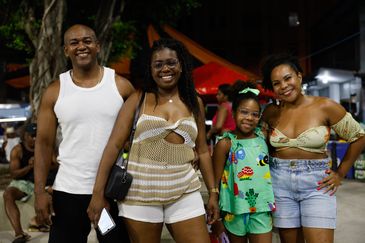The Oswaldo Cruz neighborhood, in the north of Rio de Janeiro, welcomed this Saturday (7) samba artists who made the history of the musical genre not only in Rio, but throughout the country.
The traditional Trem do Samba, which is in its 29th edition, brought together old guards, samba circles and momos kings, in a party to celebrate National Samba Day, celebrated on December 2nd.
The party started at the Central do Brasil station, where a stage was set up for several samba artists to perform during the afternoon. From 6:04 pm, the samba was transferred to the train carriages that took an audience of cariocas, tourists, samba lovers and curious people to the neighborhood which, next to Madureira, is the birthplace of Portela and Império Serrano, two associations with a strong history linked to samba.
Icon of the musical genre, pastor of the Velha Guarda and honorary president of Portela, Iranette Ferreira Barcellos, known as Tia Surica, was one of the samba dancers who occupied the stage at Central do Brasil.
“It’s the samba dancers’ meeting. So for us, who are already veterans, this is fundamental”, he said and quoting Dorival Caymmi, he spoke about the importance of rhythm.
“For me, samba is everything, without samba I am nobody. You see, you know, whoever doesn’t like samba isn’t a good guy”, he smiled.
Tia Surica has a long history in samba. In 2003, he began preparing the traditional feijoada, in his own house, to bring together samba artists who participated in the recording of his first CD. Today, Feijoada da Tia Surica is a Historical and Cultural Heritage Site of the State of Rio de Janeiro.
She says that she has a samba that she has a fondness for: Memoirs of a Militia Sergeant. In 1966, she was one of the leaders of this samba-plot, written by Paulinho da Viola, which led Portela to become champion of the Rio de Janeiro carnival that year: “I was born in samba and I will die in samba.”
In addition to members of the old guards of samba schools, the stage also welcomed symbolic figures of carnival: the Reis Momos. “If there is samba, there has to be Rei Momo”, said the president of the Associação dos Reis Momos, Alex de Oliveira, who invited Reis Momos from all over the country to be present at the event.
King Momo is an ancient figure from Greco-Roman mythology, he worshiped banquets and parties. Since the 1930s, it has come to symbolize Carnival. For Oliveira, it also represents something much stronger:
“The inversion of values. Show that all those who have many difficulties, at Carnival, become kings. This is the biggest importance. Everyone realizes that the magic of samba is this power to transform our realities.”
This transformation is in the lyrics. In one of the carriages of the Samba Train, the Velha Guarda from the Império Serrano school, evokes the group Fundo de Quintal: “The show must go on”.
6:04 pm train
THE Samba Train is inspired by the train journey that Paulo da Portela, founder of the samba school who lived between 1901 and 1949, and other samba artists, took at the beginning of the 20th century, to escape police repression of the musical genre.
Exactly at the same time they were heading to Oswaldo Cruz, at 6:04 pm, the first train left Central, taking the old guards of the samba schools and guests to the end of the journey. In each carriage, a samba circle.
Samba is resistance, it emerged in Afro-Brazilian communities and is a musical expression characteristic of poor neighborhoods. It wasn’t just during Paulo da Portela’s time that he was attacked. Throughout history, the genre that is today Brazilian Intangible Cultural Heritage has had many of its members persecuted.
During the years of the military regime, for example, repression and censorship were imposed on the activities of samba dancers. Until that moment, the police raids they suffered were due to discrimination because samba dancers were considered a marginalized category of society. With the dictatorship, the situation worsened.
“All of our goods are intangible, here is a kind of museum of intangible goods. The Samba Train is a kind of restorer of these works of art because it makes us not forget. This is the biggest importance for me”, says the host of Trem do Samba, Marquinhos de Oswaldo Cruz.
Samba is root
Judicial analyst Isabel Cristina de Souza, 49 years old, and her husband, machinist Samuel de Souza, 58 years old, brought together a group from Campo Grande, in the West Zone of the city, to learn about the event. Wearing customized abadás, they approved the party.
“Personally, I’m a rocker, but I like samba, because it’s in our roots, right? We wanted to know what it was like”, said Isabel. “We are loving it.”
For the veterans at the party, accountant Marcelle Liberato, 37 years old, and her husband, industrial mechanic Renato Liberato, 37 years old, samba is family.
“This event here is traditional for us. Every year we come. We really like the Samba Train. We like to take a train, get off here and participate in the chaos, singing a pagode. This is our culture, it’s part of it. Samba represents my family, we grew up with samba, so samba is the same thing as family”, said Marcelle.
The couple’s friend, public servant Fernanda Arcanjo, 34 years old Beatriz, also brought her daughter, Beatriz, 8 years old, who, when asked if she likes samba, is categorical: “Yes”.





















